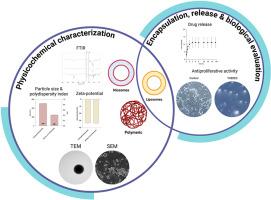用于包封治疗性深共晶系统以靶向结直肠癌细胞的纳米颗粒平台
IF 4.9
3区 医学
Q1 PHARMACOLOGY & PHARMACY
Journal of Drug Delivery Science and Technology
Pub Date : 2025-09-10
DOI:10.1016/j.jddst.2025.107517
引用次数: 0
摘要
鉴于深共晶系统(DES)因其卓越的物理化学和生物学特性以及与绿色化学原理的一致性而日益受到关注,我们在本研究中探索了其治疗结直肠癌(CRC)的潜力。据报道,将萜烯(薄荷醇、百里香酚、紫苏醇和柠檬烯)与布洛芬(Ibu)结合的治疗性深共渗系统(THEDES)对结直肠癌细胞的选择性毒性很有希望,这促使它们成为结直肠癌的潜在替代或补充治疗方法。这些系统被认为是THEDES,因为它们是共晶系统,药物成分是其组成的一部分。为了利用THEDES作为结直肠癌治疗药物的可行性,研究人员探索了基于聚乳酸-羟基乙酸纳米颗粒(PLGA-NPs)、脂质体(LPS)或脂质体的不同药物递送系统(DDS),以确保THEDES在癌症部位的积累。为此,分别采用纳米沉淀法、微流体法和薄膜水化法制备了THEDES包封DDS。从不同的DDS中,LPS在尺寸(200 nm)、单分散性和平均- 30 mV的负zeta电位方面表现出最有希望的结果。这些结果表明,LPS是一种稳定的单分散颗粒悬浮液,适合于癌症相关应用,因此,选择这些NPs进行进一步评估。所得的THEDES-LPS在电镜观察(TEM)下显示出预期的形貌,96h后释放率为10%,柠檬烯(Lim):伊布(4:1)的最大包封率(EE%)为41%。所有THEDES-LPS都显示出对HT-29细胞的抗增殖活性,这将LPS视为THEDES对CRC的DDS。本文章由计算机程序翻译,如有差异,请以英文原文为准。

Nanoparticle platforms for encapsulation of therapeutic deep eutectic systems to target colorectal cancer cells
Given the growing interest in deep eutectic systems (DES) for their remarkable physicochemical and biological properties, and their alignment with green chemistry principles, we explored their therapeutic potential against colorectal cancer (CRC) in this study. The reported promising selective toxicity of therapeutic deep eutectic systems (THEDES), combining a terpene (menthol, thymol, perillyl alcohol and limonene) with ibuprofen (Ibu), towards CRC cells, have pushed them forward as potential alternative or complementary therapeutics towards CRC. These systems are considered THEDES since they are eutectic systems with a pharmaceutic ingredient as part of its composition. To leverage THEDES viability as CRC therapeutics, different drug delivery systems (DDS), based on poly (lactic-co-glycolic acid) nanoparticles (PLGA-NPs), liposomes (LPS) or niosomes, were explored to ensure THEDES accumulation in cancer sites. For that, nanoprecipitation, microfluidics and thin-film hydration methods were used, respectively, to produce THEDES encapsulated DDS. From the different DDS produced, LPS presented the most promising results regarding size (200 nm), monodispersity, and negative zeta potential averaging −30 mV. These results indicate LPS as a stable, monodispersed particle suspension suitable for cancer-related applications, hence, these NPs were selected for further assessments. The obtained THEDES-LPS revealed expected morphology upon electron microscopy observation (TEM), a 10 % release after 96h, and a maximum encapsulation efficiency (EE%) of 41 % obtained for limonene (Lim):Ibu (4:1). All THEDES-LPS revealed antiproliferative activity towards HT-29 cells which envisage LPS as a DDS for THEDES towards CRC.
求助全文
通过发布文献求助,成功后即可免费获取论文全文。
去求助
来源期刊
CiteScore
8.00
自引率
8.00%
发文量
879
审稿时长
94 days
期刊介绍:
The Journal of Drug Delivery Science and Technology is an international journal devoted to drug delivery and pharmaceutical technology. The journal covers all innovative aspects of all pharmaceutical dosage forms and the most advanced research on controlled release, bioavailability and drug absorption, nanomedicines, gene delivery, tissue engineering, etc. Hot topics, related to manufacturing processes and quality control, are also welcomed.

 求助内容:
求助内容: 应助结果提醒方式:
应助结果提醒方式:


